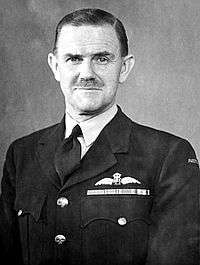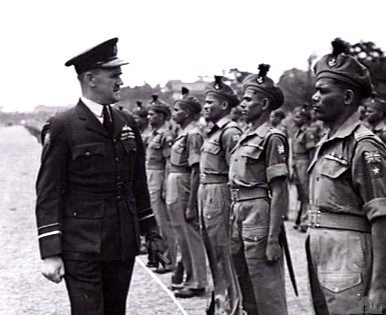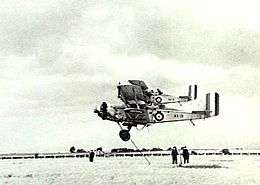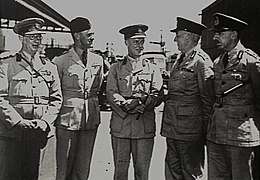Frank Bladin
Air Vice Marshal Francis Masson (Frank) Bladin, CB, CBE (26 August 1898 – 2 February 1978) was a senior commander in the Royal Australian Air Force (RAAF). Born in rural Victoria, he graduated from the Royal Military College, Duntroon, in 1920. Bladin transferred from the Army to the Air Force in 1923, and learned to fly at RAAF Point Cook, Victoria. He held training appointments before taking command of No. 1 Squadron in 1934. Quiet but authoritative, he was nicknamed "Dad" in tribute to the concern he displayed for the welfare of his personnel.[1]
Francis Masson (Frank) Bladin | |
|---|---|
 Air Commodore Frank Bladin, 1943 | |
| Nickname(s) | "Dad" |
| Born | 26 August 1898 Korumburra, Victoria |
| Died | 2 February 1978 (aged 79) Melbourne |
| Allegiance | Australia |
| Service/ | Royal Australian Air Force |
| Years of service | 1920–1953 |
| Rank | Air Vice Marshal |
| Unit |
|
| Commands held |
|
| Battles/wars | World War II
|
| Awards |
|
| Other work | Grazier RSL National Treasurer |
Ranked wing commander at the outbreak of World War II, by September 1941 Bladin had been raised to temporary air commodore. He became Air Officer Commanding North-Western Area in March 1942, following the first Japanese air raids on Darwin, Northern Territory. Personally leading sorties against enemy territory, he earned the United States Silver Star for gallantry. In July 1943, Bladin was posted to No. 38 Group RAF in Europe, where he was mentioned in despatches. He was appointed a Commander of the Order of the British Empire the same year.
Promoted acting air vice marshal in 1946, Bladin was among the coterie of senior officers who helped reshape the post-war RAAF. His roles in the late 1940s and early 1950s included Chief of Staff of the British Commonwealth Occupation Force in Japan, Air Officer Commanding Eastern Area (later RAAF Air Command), and Air Member for Personnel. Appointed a Companion of the Order of the Bath in 1950, he retired to his country property in 1953. He was active for many years in veterans' affairs before his death in 1978 at the age of seventy-nine.
Early career
Frank Bladin was born on 26 August 1898 in Korumburra, Victoria, the youngest son of engineer Frederick Bladin and his wife Ellen.[2][3] Educated to junior public level at Melbourne High School, he sought to join the Australian Imperial Force during World War I. His parents refused their permission, and he instead entered the Royal Military College, Duntroon, in 1917.[4][5] Graduating in 1920, Bladin served for the next two years in the Australian Army, including sixteen months seconded to the Royal Field Artillery in Britain.[2][6] He transferred to the recently established Royal Australian Air Force as a flying officer in January 1923.[4][5] Undergoing pilot training at Point Cook, Victoria, he was one of five former Army lieutenants on the inaugural RAAF flying course—all of whom had left their original service at least partly because of poor career prospects in the post-war military. One of Bladin's other classmates on the course was a 1919 graduate of the Royal Australian Naval College, Sub-Lieutenant Joe Hewitt.[7] During 1925–26, Bladin was in charge of running Citizens Air Force (reserve) pilots' courses at No. 1 Flying Training School, Point Cook.[8] Having been promoted to flight lieutenant, he married Patricia Magennis at Yass, New South Wales, on 20 December 1927; the couple had a son and two daughters.[3][9]
Bladin was posted to Britain in 1929 to attend RAF Staff College, Andover, and wrote an article on Empire air defence in 1931 for Royal Air Force Quarterly, one of the few published pieces of work on air power produced by RAAF officers in the pre-war years.[10] Promoted to squadron leader, he took over as Commanding Officer of No. 1 Squadron from Squadron Leader Frank Lukis in April 1934.[11] Bladin found that the unit, flying Westland Wapitis and Hawker Demons out of RAAF Station Laverton in Victoria, "had not operated under field conditions away from its brick hangars and concrete tarmac since its inception some eight years previous". He proceeded to change this, deploying the squadron 300 miles away to Cootamundra in rural New South Wales, where he "borrowed a portion of a sheep station from a friend so that the pilots could carry out their bombing practice" over a two-week period commencing in late November 1935.[12]
After completing his tenure with No. 1 Squadron in December 1935,[11] Bladin was appointed Officer Commanding Cadet Squadron at No. 1 Flying Training School. He modelled the squadron's training course on that of Duntroon, foreshadowing instruction at the Air Force's own cadet institute, RAAF College,[13] which would be established in 1947.[14] On 12 March 1937, he was promoted to wing commander.[2]
World War II
Bladin's first posting following the outbreak of World War II was as Director of Operations and Intelligence at RAAF Headquarters, Melbourne, in March 1940. Promoted to group captain in June, he became Air Officer Commanding Southern Area in August 1941 and was raised to acting air commodore the following month.[2][4] By 1 January 1942, Bladin was serving as Assistant Chief of the Air Staff (Operations), charged with readying air bases and putting into effect plans for the Empire Air Training Scheme.[15][16] He took over as Air Officer Commanding North-Western Area (AOC NWA) on 25 March that year.[17]
Based in Darwin, Bladin's role was to conduct the air defence of Torres Strait, the Northern Territory, and north Western Australia.[1] He also had to restore morale following the bombing of Darwin on 19 February and deal with the threat of imminent invasion, tasks complicated by the poor state of local communications, transport and early warning systems.[1][17] Initiating combat training for all RAAF ground crew, Bladin constructed secondary airfields so he could disperse his forces. He became, in the words of historian Dr Alan Stephens, "the RAAF's outstanding area commander of the war", and earned distinction as the first Australian decorated by the United States in the Pacific theatre of operations when he was awarded the Silver Star for gallantry.[1] The cited action took place in June when Bladin personally led a raid by USAAF B-17 Flying Fortresses on Celebes in the Dutch East Indies. As well as destroying enemy machines on the ground and damaging infrastructure, the Allied bombers managed to evade an attack by nine Japanese fighters during their return to base.[2] Bladin's award was recommended in September, and promulgated in the Australian Gazette on 23 November 1944.[18][19]
By December 1942, Bladin's strength in NWA consisted of seven RAAF squadrons operating mainly Bristol Beaufighter and P-40 Kittyhawk fighters, Lockheed Hudson light bombers, and A-31 Vengeance dive bombers. These were soon augmented by one squadron each of Dutch East Indies B-25 Mitchell medium bombers and USAAF B-24 Liberator heavy bombers.[20] As Japanese air raids continued into 1943, Bladin placed his bombers inland, and his fighters close to the coast where they could intercept the raiders.[21] Appointed a Commander of the Order of the British Empire on 1 January 1943,[22] he stepped up offensive strikes against island bases and shipping in the Timor and Arafura Seas as the Allies took the fight to the Japanese.[1] He often employed his own judgement in the selection of targets, as detailed directives from superior headquarters were not always forthcoming.[16] On 27 February, acting on intercepted radio transmissions, he launched a pre-emptive raid on Penfui airfield, near Koepang on Timor, which destroyed or damaged twenty-two enemy bombers that had been destined to make a major raid on Darwin.[20]

To help protect northern Australia from ongoing air attack, three squadrons of Spitfire fighters were transferred from the United Kingdom in late 1942, becoming operational in March 1943 as No. 1 Fighter Wing.[20] A major engagement over Darwin on 2 May resulted in eight Spitfires crashing and several others making forced landings, for the destruction of one Japanese bomber and five fighters. An adverse communiqué concerning the action was issued from General Douglas MacArthur's headquarters and was picked up by Australian newspapers, which reported the Spitfires' "heavy losses" and caused resentment in NWA. Bladin complained to his superior, Air Vice Marshal Bill Bostock, that the "alarmist tendency of the press and radio references was having a bad effect on the combat pilots". He also ordered an immediate Beaufighter strike led by Wing Commander Charles Read against Penfui airfield, on the assumption that this was where the Japanese raiders were based; four enemy aircraft were destroyed on the ground.[23] On 17 June, under the command of Group Captain Clive Caldwell, No. 1 Fighter Wing recorded NWA's most successful interception to date, claiming fourteen Japanese raiders destroyed and ten damaged, for the loss of two Spitfires.[24] The 380th Bombardment Group USAAF, consisting of four squadrons of Liberators, came under Bladin's control the same month, enhancing NWA's strategic strike capability.[25] When Bladin handed over North-Western Area to Air Vice Marshal Adrian Cole in July 1943, the latter reported that his new command was "well organised, keen and in good shape".[26]
Posted to England as Senior Air Staff Officer (SASO) of No. 38 Group RAF, Bladin was closely involved in training aircrew and planning airborne operations for Operation Overlord, the Allied invasion of France.[27] He flew a mission on D-Day, 6 June 1944, to deliver glider-borne troops to Normandy, and was mentioned in despatches two days later.[4][28] Completing his RAF service on the staff of the Second Tactical Air Force in France, Bladin returned to Australia to become Deputy Chief of the Air Staff in October 1944.[2][4] On two occasions in June 1945, he was considered for the position of AOC RAAF Command, the Air Force's main operational formation in the South West Pacific. Bladin would have replaced Air Vice Marshal Bostock, who was facing disciplinary action for refusing to comply with directives from the Air Board, the RAAF's controlling body, but in the end the Australian government made no change to command arrangements.[29]
Post-war career

The RAF had planned to deploy an airborne formation, No. 238 (Airborne Assault) Group, to the Pacific theatre and requested Bladin be released from his duties as Deputy Chief of the Air Staff to assume its command, but this was cancelled with the end of hostilities in August 1945. His next posting was to Kure, Japan, in January 1946, as Chief of Staff to Lieutenant General John Northcott, commander of the British Commonwealth Occupation Force (BCOF). Northcott reportedly chose Bladin not only for his operational command and staff experience in the RAAF and the RAF during World War II, but for his pedigree as a Duntroon graduate rather than having a background that was confined to the Air Force alone.[30] Promoted acting air vice marshal on 1 March 1946, he handed over to another Duntroon graduate, Air Vice Marshal John McCauley, in June 1947.[2][30] After returning to Australia, Bladin was to figure prominently, along with such figures as McCauley, Air Vice Marshal Joe Hewitt and Air Commodore (later Air Chief Marshal Sir) Frederick Scherger, in reshaping the post-war Air Force.[31]
Bladin's next command was Eastern Area, which would evolve over the years into Home Command, Operational Command and, finally, Air Command.[2][32] His acting rank of air vice marshal was made substantive on 1 October 1948.[2][33] As AOC Eastern Area, Bladin was instrumental in organising the acquisition of a new site for his then-headquarters at Bradfield Park on Sydney's North Shore, namely the former Lapstone Hotel at Glenbrook in the Blue Mountains. Subsequently known as Headquarters Operational Command, later Headquarters Air Command, the site was purchased in mid-1949, and became operational at the end of the year. As well as commanding a view of the surrounding countryside, the property was within five kilometres (three miles) of the City of Penrith and thirty kilometres (twenty miles) of RAAF Station Richmond, and incorporated a disused railway tunnel that offered, according to government correspondence, "complete protection from Atom Bomb attack".[32]

Bladin became Air Member for Personnel (AMP) on 24 November 1948; this position gave him a seat on the Air Board, which consisted of the RAAF's most senior officers and was chaired by the Chief of the Air Staff. He succeeded Joe Hewitt, and worked to consolidate the innovations in Air Force education and training that the latter had initiated.[34][35] RAAF Staff College was opened in June 1949 at Point Cook, providing an advanced defence course aimed at squadron leaders and wing commanders; various international facilities were also utilised to further officers' education.[36] In October, Bladin became involved in the push for a Junior Equipment and Administrative Training Scheme to offer apprenticeships to clerical and supply staff, which was established two years later.[37] He was appointed a Companion of the Order of the Bath in the King's Birthday Honours announced in June 1950.[38] In 1951, inspired by a similar initiative in state education, he sponsored a move to have RAAF education officers augment their degree qualifications with formal teaching credentials.[39] Over the following year, in response to increased demands for aircrew to meet Australia's commitments to the Malayan Emergency and the Korean War, pilot training was broken out from a single all-encompassing course at No. 1 Flying Training School (No. 1 FTS) in Point Cook, Victoria, into separate courses at the newly formed No. 1 Initial Flying Training School at Archerfield, Queensland, No. 1 Basic Flying Training School at Uranquinty, New South Wales, and No. 1 Applied Flying Training School (re-formed from No. 1 FTS) at Point Cook.[40]
Later life
Bladin retired from the Air Force on 15 October 1953, and was succeeded as AMP by Air Vice Marshal Val Hancock.[41][42] Shortly after leaving the Air Force, Bladin donated an eponymous trophy for the service's best-performing Avro Lincoln unit in bombing and aerial gunnery competition.[43] He ran a grazing property, which he named Adastra, at Yass, just north of the Australian Capital Territory. Between 1951 and 1954, and again from 1956 to 1969, he also served as treasurer of the Returned Sailors', Soldiers' and Airmen's Imperial League of Australia, which became the Returned Services League in 1965. In the early 1960s he helped raise funds for building the Anzac Memorial Chapel of St Paul at his old college, Duntroon. Bladin died in Melbourne on 2 February 1978, survived by his three children. His wife, who was involved in the support of veterans' families and other community work, had died earlier. Accorded an Air Force funeral at the Church of Our Lady of Good Counsel in Deepdene, Frank Bladin was buried at Springvale, Victoria.[2]
Notes
- Stephens, The Royal Australian Air Force, pp. 145–146
- Ritchie, Australian Dictionary of Biography, pp. 192–193
- "Bladin–Magennis". The Sydney Morning Herald. Sydney: National Library of Australia. 21 December 1927. p. 5. Retrieved 30 August 2011.
- Stephens; Isaacs, High Fliers, pp. 54–57
- Dennis et al, Oxford Companion to Australian Military History, p. 259
- Air Vice-Marshals (A–K) Archived 6 July 2012 at the Wayback Machine at Royal Australian Air Force. Retrieved 30 August 2011.
- Coulthard-Clark, The Third Brother, p. 192
- Coulthard-Clark, The Third Brother, p. 234
- Alexander, Who's Who in Australia 1955, p. 97
- Coulthard-Clark, The Third Brother, p. 445
- RAAF Historical Section, Units of the Royal Australian Air Force, pp. 2–5
- Coulthard-Clark, The Third Brother, pp. 190–191
- Coulthard-Clark, The Third Brother, pp. 95, 200–201
- Stephens, The Royal Australian Air Force, pp. 186–188
- Gillison, Royal Australian Air Force, p. 298 Archived 5 March 2016 at the Wayback Machine
- Stephens, The RAAF in the Southwest Pacific Area, pp. 29–31
- Gillison, Royal Australian Air Force, pp. 554–559Archived 22 October 2012 at the Wayback Machine at Royal Australian Air Force. Retrieved 30 August 2011.
- Recommendation: US Silver Star Archived 5 March 2016 at the Wayback Machine at Australian War Memorial. Retrieved 24 April 2009.
- Awarded: US Silver Star Archived 7 June 2011 at the Wayback Machine at Australian War Memorial. Retrieved 24 April 2009.
- Gillison, Royal Australian Air Force, pp. 649–651 Archived 5 March 2016 at the Wayback Machine
- Odgers, Air War Against Japan, p. 43 Archived 5 March 2016 at the Wayback Machine
- "No. 35841". The London Gazette (Supplement). 1 January 1943. p. 13.
- Odgers, Air War Against Japan, pp. 46–50 Archived 5 March 2016 at the Wayback Machine
- Odgers, Air War Against Japan, pp. 59–60 Archived 5 March 2016 at the Wayback Machine
- Odgers, Air War Against Japan, p. 61 Archived 5 March 2016 at the Wayback Machine
- Odgers, Air War Against Japan, p. 104 Archived 27 April 2015 at the Wayback Machine
- Herington, Air Power Over Europe, pp. 14–15 Archived 5 March 2016 at the Wayback Machine
- "No. 36544". The London Gazette (Supplement). 8 June 1944. p. 2642.
- Helson, Ten Years at the Top, pp. 154–159
- Stephens, The Royal Australian Air Force, pp. 212–213
- Stephens, Going Solo, p. 5
- Stephens, Going Solo, pp. 69–70
- Stephens, Going Solo, pp. 24–25
- Stephens, Going Solo, pp. 76, 118, 500
- Stephens, The Royal Australian Air Force, p. 185
- Stephens, Going Solo, pp. 142–144
- Coulthard-Clark, From the Ground Up, pp. 91–95
- "No. 34396". The London Gazette (Supplement). 8 June 1950. p. 3088.
- Stephens, Going Solo, p. 120
- Stephens, The Royal Australian Air Force, p. 199
- Bladin, Francis Masson at World War 2 Nominal Roll. Retrieved 22 April 2009.
- Stephens, Going Solo, p. 500
- "Air Weapons Contest at Canberra". The Canberra Times. Canberra: National Library of Australia. 4 December 1953. p. 2. Retrieved 30 August 2011.
References
| Wikimedia Commons has media related to Frank Bladin. |
- Alexander, Joseph A., ed. (1955). Who's Who in Australia 1955. Melbourne: Colorgravure. OCLC 221681426.
- Coulthard-Clark, Chris (1997). From the Ground Up: The Training of RAAF Technical Ground Staff, 1948–1993. Canberra: RAAF Air Power Studies Centre. ISBN 0-642-26509-7.
- Coulthard-Clark, Chris (1991). The Third Brother: The Royal Australian Air Force 1921–39. North Sydney: Allen & Unwin. ISBN 0-04-442307-1.
- Dennis, Peter; Grey, Jeffrey; Morris, Ewan; Prior, Robin (2008) [1995]. The Oxford Companion to Australian Military History. South Melbourne: Oxford University Press. ISBN 978-0-19-551784-2.
- Dalkin, R.N. (1993). "Bladin, Francis Masson (1898–1978)". In Ritchie, John (ed.). Australian Dictionary of Biography: Volume 13. Melbourne: Melbourne University Press. ISBN 0-522-84512-6.
- Gillison, Douglas (1962). Australia in the War of 1939–1945: Series Three (Air) Volume I – Royal Australian Air Force 1939–1942. Canberra: Australian War Memorial. OCLC 2000369.
- Helson, Peter (2006). Ten Years at the Top (PhD thesis). Sydney: University of New South Wales. OCLC 225531223.
- Herington, John (1963). Australia in the War of 1939–1945: Series Three (Air) Volume IV – Air Power Over Europe 1944–1945. Canberra: Australian War Memorial. OCLC 3633419.
- Odgers, George (1968) [1957]. Australia in the War of 1939–1945: Series Three (Air) Volume II – Air War Against Japan 1943–1945. Canberra: Australian War Memorial. OCLC 246580191.
- RAAF Historical Section (1995). Units of the Royal Australian Air Force: A Concise History. Volume 3: Bomber Units. Canberra: Australian Government Publishing Service. ISBN 0-644-42792-2.
- Stephens, Alan, ed. (1993). The RAAF in the Southwest Pacific Area 1942–1945. Canberra: RAAF Air Power Studies Centre. ISBN 0-642-19827-6.
- Stephens, Alan (1995). Going Solo: The Royal Australian Air Force 1946–1971. Canberra: Australian Government Publishing Service. ISBN 0-644-42803-1.
- Stephens, Alan (2006) [2001]. The Royal Australian Air Force: A History. London: Oxford University Press. ISBN 0-19-555541-4.
- Stephens, Alan; Isaacs, Jeff (1996). High Fliers: Leaders of the Royal Australian Air Force. Canberra: Australian Government Publishing Service. ISBN 0-644-45682-5.
| Military offices | ||
|---|---|---|
| Preceded by Air Commodore D.E.L. Wilson |
Air Officer Commanding North-Western Area 1942–1943 |
Succeeded by Air Vice Marshal Adrian Cole |
| Preceded by Air Commodore John McCauley |
Deputy Chief of the Air Staff 1944–1946 |
Succeeded by Air Commodore John McCauley |
| Preceded by Air Commodore Leon Lachal |
Air Officer Commanding Eastern Area 1947–1948 |
Succeeded by Air Vice Marshal John McCauley |
| Preceded by Air Vice Marshal Joe Hewitt |
Air Member for Personnel 1948–1953 |
Succeeded by Air Vice Marshal Valston Hancock |

